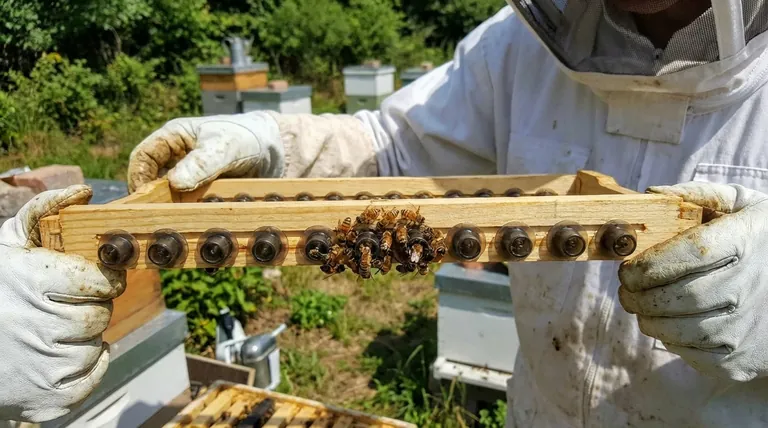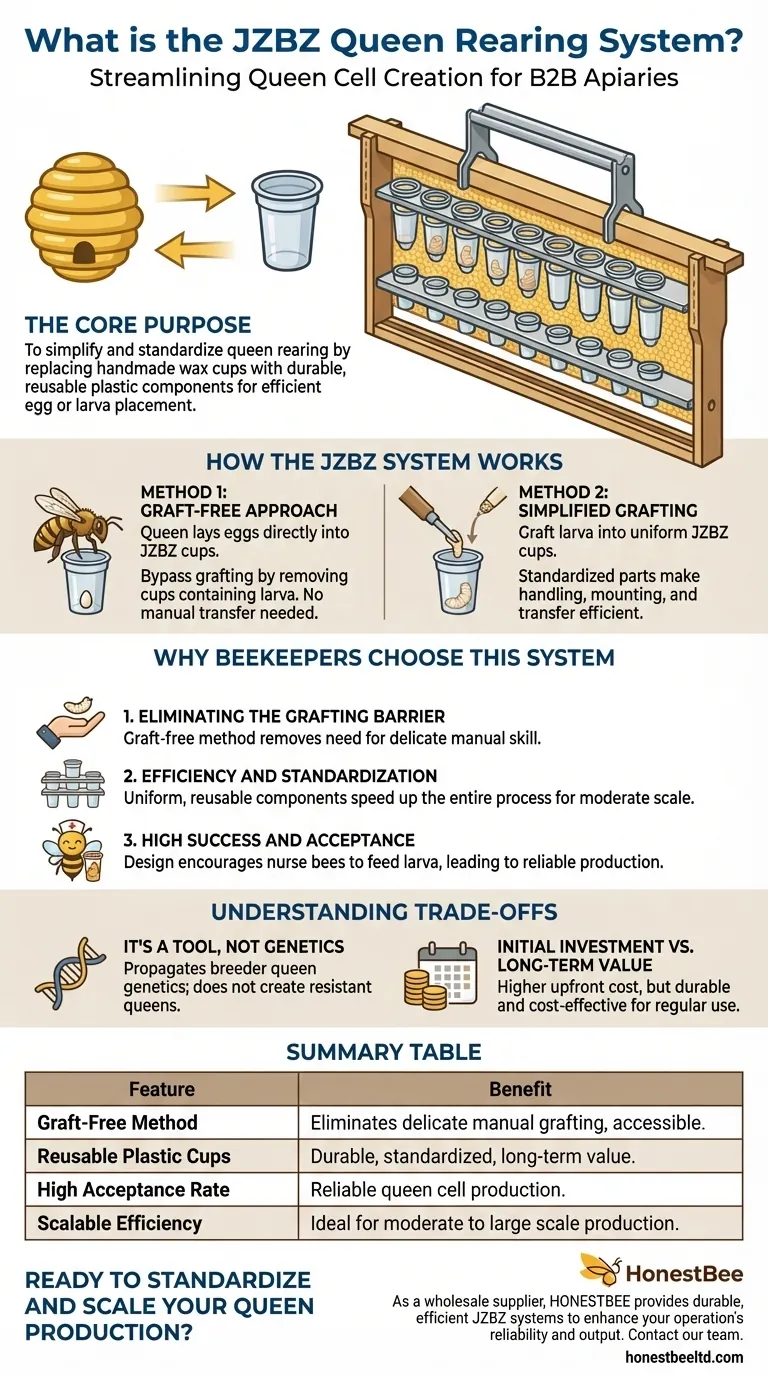In short, the JZBZ system is a specific set of tools used for queen rearing, centered around its signature plastic cell cups. It is designed to simplify and standardize the process of creating new queen bees, primarily by making it easier to get eggs or larvae into a queen cell cup, which is the first step in raising a queen.
The core purpose of the JZBZ system is to streamline the creation of queen cells. It achieves this by replacing traditional, hand-made wax cups with durable, reusable plastic components that either eliminate the need for manual grafting or make the process significantly more efficient.

How the JZBZ System Actually Works
Many descriptions incorrectly define the JZBZ system as simply the act of splitting a colony. The system is actually about the specialized equipment used to produce the queen cell before it is placed into a split or nucleus colony.
The Core Components
The system's effectiveness comes from its integrated plastic parts. The most common components are the cell cups (small brown cups where the queen is raised), cell cup holders (which attach the cup to a frame), and cell bars (which hold multiple cup holders on a frame).
Method 1: The Graft-Free Approach
This is the most popular use of the system. A beekeeper confines a breeder queen onto a frame fitted with the JZBZ cell cups. The queen lays eggs directly into these plastic cups.
Once the eggs are laid, the beekeeper can remove the cups (now containing a tiny larva) without ever having to touch the larva itself. This completely bypasses the most difficult part of queen rearing: grafting.
Method 2: Simplified Grafting
Alternatively, beekeepers can use the JZBZ cell cups for traditional grafting. Instead of grafting a larva into a handmade wax cup, they graft it into the uniform, easy-to-handle plastic JZBZ cup.
While this still requires the skill of grafting, the system's standardized parts make handling, mounting, and transferring the queen cells much more efficient.
Why Beekeepers Choose This System
The decision to use a system like JZBZ revolves around a trade-off between skill, scale, and convenience.
Eliminating the Grafting Barrier
Grafting is the process of manually transferring a day-old larva from a worker cell to an artificial queen cup. It requires excellent eyesight, a steady hand, and significant practice.
The JZBZ system's "graft-free" method removes this requirement entirely, making queen rearing accessible to beekeepers who struggle with or wish to avoid grafting.
Efficiency and Standardization
For beekeepers looking to raise more than a few queens, consistency is key. The JZBZ components are uniform, reusable, and designed to fit together perfectly.
This standardization speeds up the entire process, from setting up the cell-builder colony to moving finished queen cells into mating nucs.
High Success and Acceptance
The design and texture of the cell cups are widely reported to have high acceptance rates by the nurse bees. This means the bees are more likely to accept the cup and feed the larva inside, turning it into a queen.
Understanding the Trade-offs and Misconceptions
While powerful, the JZBZ system is a tool, and its benefits must be understood in the proper context.
It's a Tool, Not a Genetic Program
The system itself does not produce "mite-resistant" or "more productive" queens. It is simply a method for propagating the genetics of the breeder queen you select. The quality of your queens is determined by the quality of your breeding stock, not the plastic cups they are raised in.
Initial Investment vs. Long-Term Value
A JZBZ kit represents a higher upfront cost compared to making your own wax cups. However, the components are durable and can be reused for many years, making it a cost-effective solution for anyone planning to raise queens regularly.
The "Split" Confusion
To be clear: the JZBZ system is used to create the queen cell. That finished queen cell is then introduced into a queenless colony, which is often a small "split" or "nucleus colony." The system is for producing the queen, not for the separate act of making the split itself.
Making the Right Choice for Your Goals
Your beekeeping goals will determine if this system is the right fit for your operation.
- If your primary focus is simplicity and avoiding grafting: The JZBZ system is an excellent choice, as its graft-free method is its main selling point.
- If your primary focus is producing queens at a moderate scale: The efficiency and reusability of the standardized components make this system highly effective.
- If your primary focus is minimal cost for only one or two queens: Traditional methods using homemade wax cups remain the cheapest entry point, provided you are willing to learn the skill of grafting.
Ultimately, the JZBZ system empowers a beekeeper to reliably produce queen cells by replacing a delicate manual skill with an efficient, repeatable process.
Summary Table:
| Feature | Benefit |
|---|---|
| Graft-Free Method | Eliminates the need for delicate manual grafting, making queen rearing accessible. |
| Reusable Plastic Cups | Durable, standardized components ensure consistency and long-term value. |
| High Acceptance Rate | Design encourages nurse bees to feed larvae, leading to reliable queen cell production. |
| Scalable Efficiency | Ideal for beekeepers producing queens at a moderate to large scale. |
Ready to standardize and scale your queen production?
As a wholesale supplier to commercial apiaries and beekeeping equipment distributors, HONESTBEE provides the durable, efficient JZBZ systems and other essential equipment you need to enhance your operation's reliability and output.
Contact our expert team today to discuss your specific needs and discover how our wholesale-focused solutions can benefit your business.
Visual Guide

Related Products
- JZBZ Type Wide Base Plastic Queen Cell Cups for Base Mounting and Queen Rearing
- No Grafting Queen Rearing Kit: System for Royal Jelly Production and Queen Rearing
- Brown Nicot Queen Cell Cups for Breeding Queen Bees Beekeeping
- JZBZ Push-In Queen Cell Cups for Beekeeping
- Double Head Beekeeping Grafting Tools for Beekeepers
People Also Ask
- What are some common reasons bees construct queen cells? Decode Your Hive's Vital Signals
- How should cells be distributed in hot weather? Maximize Viability with Evening Application
- What are the signs that a queen cell is about to emerge? Master the Critical Timing for Hive Success
- What happens when a queen cell is introduced into a queenless colony? Ensure Successful Requeening
- How are the queen cells raised after removing the plugs? Master the Art of Queen Rearing



















